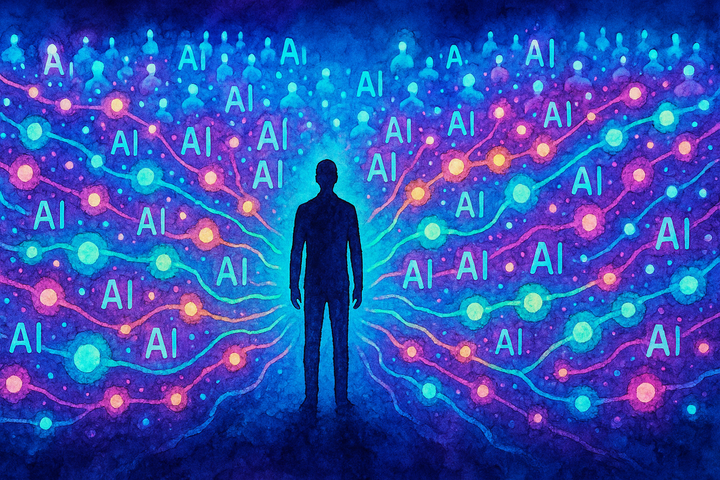Beyond AI Assistants: How Human-Agent Teams Will Transform Organizations
The true disruption of AI isn’t automation-it’s reorganization. Microsoft’s Frontier Firm research reveals a fundamental shift: 47% of companies now use AI agents to fully automate workflows, but the real transformation lies in how these digital colleagues are rewriting the rules of collaboration.

The true disruption of AI isn’t automation-it’s reorganization. Microsoft’s Frontier Firm research reveals a fundamental shift: 47% of companies now use AI agents to fully automate workflows[1], but the real transformation lies in how these digital colleagues are rewriting the rules of collaboration. We’re moving from static org charts to fluid Work Charts-dynamic team structures where humans and AI agents partner like precision instruments in an orchestra[2].
The Silo-Crushing Power of AI Partnerships
Traditional functional silos-the R&D vs. marketing divide, engineering vs. customer service chasm-are collapsing under AI’s integrative force. Josh Bersin’s analysis shows AI acts as the “great integrator,” connecting data streams that ERP systems failed to unify[3]. At Procter & Gamble, Harvard researchers found AI eliminated expertise bottlenecks: R&D teams produced commercially viable solutions while business units developed technical prototypes-a role reversal unimaginable in pre-AI organizations[4].
Microsoft’s Work Trend Index reveals why this matters: 71% of Frontier Firm employees report cross-functional collaboration vs. 42% in traditional companies[1:1]. Accenture’s 450 AI agents don’t just automate tasks-they create a lingua franca across departments, translating supply chain data into financial forecasts and customer insights into R&D roadmaps[1:2].
"We don't need a strategist on every brief. Everyone has access to that expertise via our platform."Mike Barrett, Supergood Advertising[1:3]
From Org Charts to Work Charts: The New Team Topology
The traditional organizational hierarchy is evolving into what Microsoft terms the Work Chart-a dynamic, outcome-driven model resembling movie production crews[2:1]. Key features:
- Goal-Oriented Pods: Teams form around specific objectives (e.g., product launches), dissolving after project completion
- Expertise on Demand: AI agents provide instant access to specialized skills (market analysis, regulatory compliance)
- Fluid Resourcing: Human-Agent ratios adjust based on project phase (more agents during data crunching, more humans during creative ideation)
Dow’s supply chain transformation exemplifies this shift. Their AlphaDow AI handles routine logistics, while human teams focus on exception management and supplier relationships-a division that’s projected to save millions annually[1:4]. This mirrors the “efficient frontier” concept from portfolio theory, optimizing the risk-reward balance between human judgment and AI efficiency[5].
The Human-Agent Ratio: Finding the Sweet Spot
Harvard’s groundbreaking study with 776 P&G professionals revealed a critical insight: Individuals using AI match the performance of human teams, but AI-enhanced teams outperform all[4:1]. This creates a new leadership imperative-calculating the optimal Human-Agent Ratio (HAR) for each function:
| Department | Recommended HAR | AI Focus Area | Human Focus Area |
|---|---|---|---|
| Customer Service | 1:8 | Routine inquiries | Complex escalations |
| R&D | 1:3 | Data analysis | Hypothesis generation |
| Marketing | 1:5 | Campaign analytics | Brand strategy |
Source: Microsoft Work Trend Index 2025[1:5]
Wells Fargo’s implementation showcases HAR in action: An AI agent handles 75% of banker queries (response time: 30 seconds vs. 10 minutes), freeing humans for high-touch financial planning[1:6]. But as Oxford economist Daniel Susskind warns, ratios must account for three human anchors[6]:
- Efficiency Limits: Where human-AI collaboration outperforms either alone
- Preference Limits: Situations where stakeholders demand human interaction
- Moral Limits: Decisions requiring ethical judgment beyond algorithmic parameters
The Irreplaceable Human Edge
While AI excels at scale and speed, Frontier Firms identify four human capabilities that define competitive advantage:
- Judgment in Ambiguity
When Holland America’s AI concierge faces novel passenger requests, human staff intervene-not because the AI can’t answer, but because nuanced empathy drives customer loyalty[1:7]. - Creative Synthesis
Estée Lauder’s Trend Studio AI identifies emerging patterns, but human strategists craft the narrative connecting K-pop trends to skincare innovation[1:8]. - Ethical Navigation
As AI handles 80% of Wells Fargo’s fraud detection, humans adjudicate edge cases where financial hardship complicates policy enforcement[1:9]. - Cross-Domain Imagination
Bayer’s crop scientists use AI-simulated plant models, then devise real-world applications merging agricultural science with climate tech[1:10].
Microsoft’s data confirms this divide: Employees primarily use AI for 24/7 availability (42%) and machine speed (30%), while relying on humans for judgment-intensive tasks[1:11]. The result? A new collaboration paradigm where AI handles the “what” and humans own the “why.”
The Road Ahead: From Experimentation to Integration
Organizations leading this shift exhibit three markers:
- Fluid Skill Stacking: Employees like Accenture’s engineers now spend 60% of their time training/managing AI agents vs. hands-on coding[1:12]
- Dynamic Resourcing: Dow scales its AI logistics fleet during peak seasons while maintaining core human oversight[1:13]
- Ethical Guardrails: Microsoft’s Frontier Firms report 2X faster AI adoption when paired with robust governance frameworks[1:14]
As Work Charts replace org charts, the companies thriving aren’t those with the most AI-but those who best orchestrate human-AI symbiosis. The next frontier? Developing “hybrid intelligence” systems where, as Harvard’s Karim Lakhani notes, “the whole becomes greater than the sum of its human and machine parts”[7].
- Microsoft Work Trend Index. (2025). The Frontier Firm Transformation ↩︎ ↩︎ ↩︎ ↩︎ ↩︎ ↩︎ ↩︎ ↩︎ ↩︎ ↩︎ ↩︎ ↩︎ ↩︎ ↩︎ ↩︎
- Petri.com. (2025). Microsoft Details AI Agent Impact on Future Work ↩︎ ↩︎
- Bersin, J. (2025). Breaking Down Workplace Silos Through AI Integration. HR Executive ↩︎
- Dell’Acqua, F. et al. (2025). The Cybernetic Teammate. Harvard Business School ↩︎ ↩︎
- Microsoft Support. (2025). Efficient Frontier Analysis in Project Management ↩︎
- Susskind, D. (2025). What Will Remain for People to Do? Knight First Amendment Institute ↩︎
- Microsoft WorkLab. (2025). AI at Work: Reshaping Your Workforce ↩︎



Comments ()